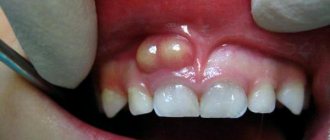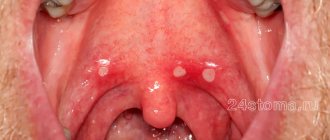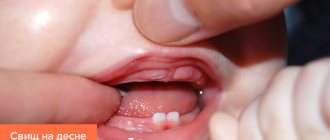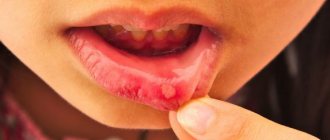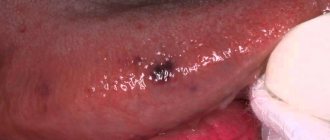Why are Bednar's aftas called exactly that - after the surname of their first researcher? Are they something special?
Yes, they, which are quite common in dentistry, differ sharply from other symptoms and disorders. And the differences from other types of ulcers of the oral mucosa are absolute.
Firstly, this is a disease exclusively of childhood, and secondly, the localization and appearance of ulcers are typical signs specifically for Bednar's aphthae. Finally, the disease has features and course that are characteristic of them.
And it all starts with the thumb. More precisely, from his sucking. It has long been noted that Bednar's aphthae are more common in children who suck their thumbs. The favorite object of the process is the thumb.
Bednar's aphthae occur precisely in the area where this finger rests, supported from below by the tongue. This is the zone of the palate, or more precisely, the border between the hard palate and the soft palate.
The mucous membrane in this zone is not particularly thick, and if it is compressed for a long time between the palatine bones, on the one hand, and a foreign object of sufficient hardness in the mouth, on the other, it is damaged. And immediately to its entire depth (thickness).
The mechanism of injury in the formation of Bednar ulcers is comparable to that in the formation of pressure ulcers. Therefore, as with it, the depth of tissue necrosis is significant.
Thus, the “sweet finger”, with which the child does not want to interrupt communication day or night, becomes the cause of a serious illness.
Origin of the disease
The origin of chronic recurrent aphthous stomatitis and the mechanisms of its formation have not yet been established. Some experts believe that L-form streptococci are to blame, but other researchers think that this type of stomatitis is provoked by viral microorganisms. Researchers also note the influence of hereditary factors. While studying aphthous stomatitis, some scientists noted the processes of trophineurotic changes.
It has not yet been established exactly why this pathology occurs.
The determining factors for the emergence of HRAS are:
- damage in the mouth;
- stressful conditions;
- some food products - chocolate, coffee, peanuts, eggs, cheeses, tomatoes, strawberries, cereals.
Eating certain foods, such as strawberries, can cause canker sores.
Some factors may be protective for unknown reasons: taking oral contraceptives, being pregnant, smoking or using smokeless tobacco, nicotine tablets.
Taking oral contraceptives may be a protective factor.
Scientists have also revealed that chronic recurrent aphthous stomatitis can be identified by clear manifestations of reduced immune reactivity and violations of nonspecific defense. Such conditions are explained by the vital activity of infectious microorganisms (for example, with sore throat, tonsillitis, pharyngitis or digestive problems). In addition, constant stress, acclimatization, etc. affect.
HRAS
T-lymphocytes fall, it becomes more difficult for them to fulfill their purpose. Due to the high number of T-suppressors, the number of T-helpers decreases.
Functions of T lymphocytes
The nature of the pathology and the extent of CRAS are associated with the sensitization of the human body by antigens. The norms of nonspecific humoral and cellular defense are violated - the concentration of lysozyme is also disrupted, and more B-lysines are found in the blood serum. Leukocytes are weakened, phagocytic activity against many microbes decreases, and its increase is noticed in Str. salivarius and C. albicans. If there are problems with local oral protection in children, the concentration of lysozymes is also disturbed, the amount of B-lysines increases, and the IgA content in secretions and serum is also disturbed. Because of this, problems arise with the resistance of the oral mucosa to pathological microorganisms, the microflora is disrupted, there are more microbes in the mouth, and they infect the body more strongly. Thanks to this, bacterial sensitization of the child’s body affected by the disease increases.
Due to the fact that the concentration of lysozymes decreases, stomatitis occurs
During HRAS, a large role is played by the cross-immune reaction: the child’s oral mucosa is replete with many types of streptococci, which are characterized by antigenic similarity to the cells of the oral mucosa. Scientists have found that the mucous membrane itself is sometimes a depot of these antigens. Children suffering from this type of stomatitis are susceptible to distortions in the recognition processes of genetic T-lymphocyte target cells. They also have a rich antigenic spectrum on the oral mucosa. As a result of these factors, the process of antibody-dependent cytotoxicity, which underlies the disease, is activated.
This pathology occurs especially often in children.
Treatment options
Treatment of chronic stomatitis does not require hospitalization. It can be successfully carried out at home. First of all, the cause of recurrent aphthous stomatitis should be eliminated: remove plaque, get rid of caries, limit contact with allergens, cure gastrointestinal diseases, autoimmune diseases, give up bad habits.
At the same time, the dentist prescribes the following medications:
- ointments that promote rapid healing of ulcers,
- tablets to combat harmful microorganisms that cause recurrent stomatitis,
- vitamins,
- medicated solutions for mouth rinsing,
- painkillers.
In addition to the basic treatment of Setton's aphthosis, you can use traditional medicine:
- rinse your mouth with decoctions of chamomile and calendula,
- treat your mouth with rosehip or sea buckthorn oil,
- rinse with baking soda solution (1 teaspoon per glass of warm water),
- drink rosehip decoction.
Dentists also recommend that during the treatment of recurrent aphthous stomatitis, avoid foods that irritate the mucous membrane and can damage it (sour, salty, sweet and spicy), concentrated juices, alcohol, and cigarettes. It is advisable to drink plenty of water and maintain enhanced oral hygiene, especially for children (more details in the article: photos and treatment of aphthous stomatitis in children). With proper therapy, relief can occur within a week, but to completely get rid of chronic stomatitis you will have to spend a lot of time.
It should be noted that it is necessary to impeccably follow the instructions of the attending physician and not miss his appointments. Only in this case can you count on a positive effect.
Differential diagnosis of aphthous stomatitis
Chronic recurrent aphthous stomatitis should be differentiated:
- with chronic recurrent herpetic stomatitis, which is characterized by multiple aphthous rashes on the mucous membrane of the mouth, lips and skin around the lips. The mucous membrane is swollen, hyperemic, the gums bleed when touched, the papillae are hyperemic, barrel-shaped. With HRAS, the lip border and facial skin are never affected, aphthae do not merge, there is no gingivitis, and there is no reaction from the lymph nodes. The element of the lesion is a spot and aphtha, while in chronic recurrent herpetic stomatitis there is a spot, vesicle, vesicle, erosion, ulcer, crust, crack;
- with exudative erythema multiforme. This disease is characterized by polymorphism of rashes; with total erythema, blisters, vesicles, papules, erosions, ulcers can be found on the oral mucosa, and crusts and cracks can be found on the lips. There are cockade-shaped elements on the body. With HRAS, there is never polymorphism of the rashes, the red border of the lips and facial skin are not affected, the aphthae do not merge, there is no gingivitis;
- with chronic traumatic erosions and ulcers. The nature of the disease is a bad habit of biting the mucous membranes of the lips, cheeks, and tongue, which is revealed when taking an anamnesis and examining the oral cavity. Erosion due to injury is often irregular in shape, hyperemia is mild or absent, pain is insignificant;
- with secondary syphilis. This disease is characterized by the appearance of 1-2 papules, painless to the touch, located on an infiltrated, compacted cartilaginous base. The decisive factor in diagnosis in doubtful cases is serological and bacteriological testing for the presence or absence of Treponema pallidum;
- with medicinal stomatitis. Characteristic features of this disease are catarrhal inflammation of the entire oral mucosa, multiple erosions and ulcers, blisters and blisters. The medical history reveals the use of medications, most often antibiotics, sulfonamides, which have a pronounced antigenic property. In addition to changes in the oral cavity, muscle pain, joint pain, dyspeptic disorders, and urticaria are possible;
- with Vincent's ulcerative-necrotic gingivostomatitis. This is an infectious disease caused by spindle bacillus and Vincent's spirochete. Under normal conditions, spindle-shaped bacilli and spirochetes are saprophytes of the oral cavity; they are found mainly in the crypts of the palatine tonsils, in the fissures of teeth, and gingival pockets. Under certain conditions (stress, hypothermia, chronic somatic diseases), these bacilli and spirochetes can lead to the occurrence of this disease. Clinically, with Vincent's stomatitis, crater-shaped ulcers are formed, covered with abundant necrotic plaque of a dirty gray color. The plaque is easily removed and a slightly bleeding bottom is exposed. The edges of the ulcer are uneven, the surrounding mucosa is swollen and hyperemic. When the inflammatory process passes to the mucous membrane of the alveolar process, the gingival margin swells, abundant necrotic masses form along the edge, which, when removed, expose an erosive-ulcerative surface that bleeds easily. With CRAS, the aphthae do not merge, there is no inflammation of the gingival margin, the retromolar area is not affected, and the general condition does not suffer;
- with Bednar's aphthosis. This disease is characterized by small erosions that easily turn into ulcers, which are localized only at the border of the hard and soft palate. The symmetry of the location of erosions is typical. The disease affects only children in the first weeks of life, when the mucous membrane of the oral cavity in the area of the hard palate is injured when wiping this area. This disease never recurs;
- with Behcet's syndrome. This pathology is characterized by a triple symptom complex, determined by the triad of lesions - the mucous membrane of the oral cavity, the genitals and the conjunctiva of the eye. The course of the disease is chronic; the symptoms of the disease increase from relapse to relapse. Aphthae on the mucous membranes do not differ from ordinary aphthous elements, but may have the character of deep scarring aphthae. Eye damage is initially expressed in photophobia, then iritis, cyclitis, hemorrhages in the vitreous body and in the fundus appear.
Symptoms of Bednar's aphthae
The disease has a characteristic clinical picture. Irregular oval-shaped erosions form at the border between the hard and soft palate. Aphthae have clear boundaries and, as a rule, are located symmetrically, resembling a butterfly. The surface of the erosions is covered with a gray-yellow fibrinous plaque, which is almost impossible to remove. Touching the aphthae is painful, the child begins to worry and cry. If left untreated and in children with reduced immunity, erosions can merge, forming an extensive wound surface, and become an entry point for bacterial and viral infections.
Hemorrhoids kill the patient in 79% of cases
In general, the child’s condition is satisfactory, but he behaves very excitedly due to the pain of the erosive elements. At the beginning of feeding, the baby greedily sucks on the breast or bottle, then, touching the erosion, stops and cries. Feeding is interrupted, the child remains hungry and worries even more.
Causes
There are a large number of unfavorable factors that can trigger the development of the pathological process. Especially often, the disease occurs when there is a combination of several such causes.
The main risk factors for the development of chronic stomatitis are considered to be:
- Burdened heredity.
- Long-term disruption of the immune system as a result of frequent infectious diseases or pathologies of an autoimmune nature.
- Disorders of the digestive system.
- Tendency to develop allergies.
- Insufficient content of vitamins and microelements in the body, unbalanced nutrition.
- Frequent stress, chronic emotional or physical fatigue.
- Dental pathologies (caries and its complications, inflammatory processes affecting gum tissue).
- Traumatic damage to soft tissue, such as wounds caused by blows, consumption of hard foods, chemical or thermal burns.
- Using unsuitable hygiene products to care for teeth and gums (brushes with hard bristles, low-quality dental floss).
About complications, prognosis and prevention
What is also important for parents to remember is the harm from arbitrariness and attempts to independently treat a child. The disease can be treated only with constant monitoring by a dentist.
The prognosis becomes serious not only due to the patient’s weak immunity, but also due to the development of complications of the disease in the form of:
- tendency to protracted course and relapse;
- addition of a secondary infection;
- aggravation of existing somatic pathology.
Measures to prevent the condition include not only proper feeding and instilling in the child a taste for personal hygiene. This is also the creation of a normal moral climate in the family, because thumb sucking is a subconscious act of protest against the existing state of affairs, which is perceived by the child as a hostile attitude towards himself.
Therefore, the participation of a child or family psychologist in the life of a family will be very useful.
Types and symptoms of the disease
Before treating stomatitis at home, it is necessary to determine the causes and type of disease. Its infectious, viral, bacterial forms differ according to the types of treatment. A doctor can prescribe medications that will help get rid of inflammation based on identifying symptoms, test results or a smear. More than 90% of cases of stomatitis in adults are successfully cured by following the recommendations of a specialist at home. The classification presented below with detailed photos will help you understand the types of stomatitis and visually identify them.
Catarrhal
The most common type of “adult” stomatitis. Formed when the rules of oral care are violated. Mild discomfort, a slight burning sensation, pink spots on the tongue or the inner surface of the cheeks are signs of catarrhal stomatitis. Treatment in adults often does not require the use of serious medications and is carried out at home.
Ulcerative
In some cases, it is a consequence of the lack of treatment in adults for the catarrhal form of stomatitis and the connection of a bacterial infection. Most manifestations are associated with an imbalance of the natural. It is characterized by the formation of wounds with a red border, causing burning and itching. The ulcers penetrate deep into the mucous epithelium, so the treatment procedure in adults is lengthy, including antibiotic therapy. Seeing this type of disease at home is problematic due to the specific nature of its spread on the back surface of the palate closer to the tonsils.
Aphthous
In adults, it manifests itself by the formation of small round wounds - aphthae, which have a white or yellowish tint with a red edging. Sometimes it occurs with mechanical damage to the front part of the oral cavity: on the lips, cheeks, tip of the tongue. Most doctors are inclined to believe that the etymology of aphthous stomatitis is viral, citing adenoviruses and herpetic infection as the causes.
The chronic course of the disease in adults with frequent relapses indicates the presence of gastrointestinal or liver diseases. Manifested by the following symptoms: multiple lesions of the lips, cheeks, tongue; painful sensations that interfere with eating; increase in body temperature to 38. Treatment of stomatitis at home includes a set of measures related to symptomatic signs and strengthening the immune system.
- Peeling skin on the palms of the hands
- What pills to take to get rid of headaches
- Frequent urination in men
Candida
Candidal stomatitis is contagious: it is transmitted through contact in everyday life, sexually. The cause of infection is the Candida fungus. It is distinguished by a cheesy whitish coating on the tongue, cheeks, and palate. Independent attempts to remove fungal growths mechanically at home can lead to injury to the epithelium of the oral cavity and the formation of ulcers. Candidal stomatitis in adults is accompanied by a burning sensation and severe itching. For the acute form, a specific symptom is partial atrophy of taste buds.
Herpetic
The nature of this form of stomatitis is viral. A herpetic infection in the blood is a lifelong “sentence”: once it enters the body, it remains with you forever. Weakening of the immune system, stress, and nervous experiences become the trigger for the manifestation of the virus. Herpes successfully attacks the lips, corners of the mouth, the inner surface of the cheeks, and gums, forming single vesicles or colonies of bubbles with liquid. In adults, treatment of stomatitis includes the use of special medications that relieve symptoms and heal wounds.
Traumatic
Scratches, damage to the soft tissues of the mucous membrane from dentures or uneven tooth edges, burns from eating excessively hot food or drinks, chemical damage are the main causes of traumatic stomatitis. Home treatment for adults involves the use of pain-relieving ointments and gels; rinsing with herbal decoctions and... periodic lamentations: “Oh, how painful it was, I bit my lip/drank hot tea (underline as appropriate).”
Development mechanism
How to treat aphthous stomatitis in children
Children's oral mucosa is extremely sensitive to any aggressive influence of external aggressive factors. Any mechanical irritation can become a trigger that will lead to the appearance of ulcers. Thus, the affected cells are slowly restored, as a result of which numerous erosions (aphthae) form on the mucous membrane.
It is noteworthy that with a prolonged course (no treatment), a secondary infection can join the ulcers. In this case, the bottom of the aphthae becomes covered with white fibrin, and then with a thick yellow coating. The area of the ulcerative lesion naturally increases, and the regeneration process slows down even more.
Classification of the disease
Recurrent stomatitis is grouped according to the complexity of the disease, symptoms, location, and type of pathogen. The most common classification was developed by the World Health Organization. According to it, chronic stomatitis is divided into the following types:
- chronic recurrent aphthous stomatitis,
- necrotizing periadenitis,
- Behçet's disease
- Vincent's disease
- herpetic stomatitis.
Chronic recurrent form of aphthous stomatitis
Recurrent aphthous stomatitis is a chronic inflammation of the oral mucosa. Aphthae are painful round-shaped erosions. Wounds appear in the spring-autumn period. They are not transmitted, so it is impossible to get infected from a sick person. The cause is considered to be an allergic reaction of the body. However, to a greater extent, aphthoses are autoimmune stomatitis. According to severity category, they come in the following forms:
- mild - manifests itself once every two years,
- average - aphthae occur no more than twice a year,
- severe - exacerbation occurs more than three times a year.
Necrotizing peryadenitis or Setton's aphthae
Necrotizing periadenitis is a complicated form of chronic recurrent aphthous stomatitis. Setton's aphthosis is characterized by small, bothersome Setton's ulcers. The mucosal tissue underneath becomes necrotic, resulting in a deep, painful wound. Setton's canker sores heal in adults in 3-12 weeks, leaving behind a small scar. At this time, swelling of the mucous membrane may occur and the temperature may rise. The causes of this chronic disease of the oral mucosa are still unknown.
INTERESTING: classification of diseases of the oral mucosa
Behçet's disease
Behçet's disease belongs to the group of vasculitis and autoimmune stomatitis. It manifests itself in adults in the form of erosive ulcers ranging in size from 2 to 20 mm. They appear on the gums, cheeks, lips, tongue and palate, disappear within a month, but appear again 3-4 times a year. The reasons for their appearance have not been identified by science. Scientists believe that this may be influenced by infections and heredity. People aged 20-35 years are most susceptible to the disease.
Vincent's stomatitis
Vincent's stomatitis is one of the forms of recurrent aphthous stomatitis with necrotizing ulcers. Its causative agents are Vincent's spirochete and spindle-shaped rod. It also refers to autoimmune stomatitis. Accompanied by increased fatigue, migraines, aching joints and muscles, fever, and bleeding gums. Chronic stomatitis most affects men 20-30 years old. Exacerbations usually occur in the autumn.
READ ALSO: what is aphthous stomatitis and how is it treated?
Herpetic stomatitis
Herpetic stomatitis (viral) is an inflammatory process caused by the herpes virus. It is especially dangerous for young children. As a result of its development, intoxication occurs and the functioning of the nervous and immune systems is disrupted. This virus can remain in the body for a long period and not manifest itself in any way. It begins to become more active as a result of weakening of the body after a serious illness or poor-quality nutrition, vitamin deficiency, or poor oral care.
Herpetic stomatitis is transmitted by airborne droplets, so you should wash your hands thoroughly after contact with a sick person. The duration of chronic stomatitis depends on the severity. A mild form of viral etiology goes away in 1-3 weeks, a severe form takes much longer.
Other forms of chronic stomatitis
Common types of chronic stomatitis include denture stomatitis and smokers' stomatitis. The first is caused by wearing dentures. It occurs for two reasons:
- An allergic reaction to the materials used in the manufacture of the insert structure. In this case, it is enough to replace it and carry out high-quality treatment.
- Bacteria. While wearing a prosthesis, many harmful organisms accumulate on it. Insufficiently careful care can provoke the appearance of recurrent stomatitis. To prevent this from happening, it is necessary to thoroughly clean it after eating.
READ ALSO: How is the vesicular stomatitis virus transmitted?
The etiology of chronic stomatitis in smokers is the effect of nicotine. The initial stage of the disease is characterized by an unpleasant odor, dry mouth, redness and swelling of the gums. The main problem is that many find it difficult to quit smoking abruptly, so the disease quickly becomes chronic and small ulcers begin to appear.
Treatment
Treatment of chronic recurrent aphthosis should be aimed at relieving inflammation, eliminating foci of infection in the oral cavity, normalizing the functioning of the gastrointestinal tract, thyroid gland and increasing immunity.
Therapy for this disease requires an integrated approach. The treatment regimen for CRAS should be selected on an individual basis, taking into account the main clinical manifestations, the presence of concomitant pathologies and the patient’s age. For this diagnosis, desensitizing and immunomodulating therapy is practiced, vitamins and medications are prescribed to normalize the intestinal microflora.
Laser therapy is highly effective for relapses.
To relieve anxiety symptoms at the first stage of the disease, patients are prescribed:
- antiseptics: Furacilin, Etin, Chlorhexidine;
- medications with an anti-inflammatory spectrum of action (Metrogil-Denta).
At the second stage of aphthous stomatitis, the therapeutic regimen includes:
- painkillers: Novocaine, Lidocaine, anesthetic solution with glycerin;
- vitamins: group B, C, folic and nicotinic acid, Riboflavin, Pyridoxine.
To reduce inflammation, it is recommended to rinse your mouth three times a day with herbal decoctions.
At an advanced stage, therapy is supplemented with:
- applications with proteolytic enzymes intended to remove necrotic plaque: Trypsin, Chymopsin, Lidase;
- In parallel, wound healing ointments are used: Actovegil, Solcoseryl.
In order to normalize cellular metabolism in the affected areas, treatment of the disease at the third stage should be carried out in stages. First, patients are prescribed Riboxin, drugs based on lipoic acid, Cocarboxylase, Calcium Pantothenate, then Potassium Pangamate and vitamins. At the final stage, patients are prescribed keratoplasty drugs that promote normal tissue healing.
To achieve results and consolidate them for a long time, the therapeutic course must be repeated every six months. Proper treatment can reduce the number of relapses and prolong remission.
Prevention
The disease greatly reduces the child’s immunity and brings him pain. Correct and constant prevention of stomatitis in children helps prevent its occurrence. The basis is maintaining hygiene at home and taking care of health:
- Nutrition should be age appropriate and contain enough vitamins and beneficial compounds that strengthen the intestinal microflora.
- From the first days, the child is given personal oral care items and dishes, and the brush is washed with hot water every day.
- Don't forget to sterilize nipples and bottles.
- The newborn's room must be kept clean and wet cleaned.
- After the first teeth appear, visits to the dentist are carried out every 6 months.
To reduce the risk, all colds should be eliminated at the initial stage, and antiviral drugs should be used as prescribed by a doctor. If there are no contraindications, it is useful to do hardening and spend more time in the fresh air. When breastfeeding, a woman is advised to keep her skin clean and wash her hands after changing diapers.
Stomatitis: symptoms and first signs
The first sign of stomatitis, including the herpetic form, is discomfort in the oral cavity, which is accompanied by burning, itching, swelling of the mucous membrane and its bleeding. Further, characteristic ulcers are added to everything, which can cover both limited areas of mucous tissue and the entire mouth. As for the generalized form of the disease, it involves the appearance of symptoms such as a sharp increase in body temperature, weakness, and difficulty eating.
READ ALSO: main signs of stomatitis in children
The presence of aphthous stomatitis is judged by the following specific signs:
- the appearance of severe dryness in the oral cavity, noticeable redness of the mucous membrane (we recommend reading: why redness of the oral mucosa may occur?),
- swelling of the tongue and its obvious redness,
- bad breath (we recommend reading: what to do if an adult has bad breath?),
- the appearance of frequent aphthous ulcers in the oral cavity in different areas,
- swelling and aphthae on the gums requiring treatment.
A person who is faced with aphthous stomatitis loses his appetite because food seems tasteless. Moreover, with the appearance of swelling and ulcers in the mouth, eating is often accompanied by severe and unpleasant pain (we recommend reading: mouth ulcers appear: causes and methods of treatment). READ IN DETAIL: what to do if white ulcers appear in the mouth in an adult?
If aphthous stomatitis is not treated immediately after the first symptoms appear, the inflammatory process will worsen. Often, aphthous ulcers appear on the corners of the lips, on the inside of the cheeks, the palate and tonsils. To prevent the disease from spreading, you must urgently consult a doctor. The sooner treatment of aphthous stomatitis begins with concomitant cure of aphthae, the sooner recovery will occur.
Home remedies for canker sores
One natural remedy for canker sores is saline mouth rinse. Dissolve a teaspoon of salt in a glass of water and rinse your mouth with it. Salt has mild disinfectant properties and prevents superinfection of mouth ulcers.
Relief will come from drinking an infusion of mallow flowers or a decoction of flaxseed - they cover the mucous membrane, creating a layer that protects the wound from harmful external factors.
You should take care of your oral hygiene, eat healthy foods, get enough sleep, and avoid stress. Stopping gluten-containing foods for a few days will help test whether celiac disease is causing the recurring sores - stopping wheat in this case will reduce the appearance of the lesions and relieve symptoms associated with them.
Lesions in the mouth that do not heal within 2 weeks or appear several times a year should be examined by a doctor to rule out lip cancer.
Vorobyova Marina
Neurologist of the highest qualification category (work experience 14 years), doctor of neurofunctional diagnostics (work experience 12 years); author of scientific publications on vertebroneurology; participant of scientific conferences on neurology and functional diagnostics of all-Russian and international significance.
Forms of the disease
Aphthous stomatitis (treatment in adults and children depends on the type and stage of the disease) has 2 types: acute and chronic.
Chronic relapsing
Most patients experience a chronic course of the disease, which is recurrent in nature. Basically, this occurs due to the lack of timely treatment of acute stomatitis or the presence of a constant allergen. The cause of the chronic type of the disease can also be a blood disease, manifested by a decrease in neutrophils in tests.
Exacerbation is observed in response to the slightest irritants:
- cold;
- spicy and salty foods;
- weakened immunity due to a viral or bacterial disease;
- constant tension and stress;
- drinking hot liquid;
- taking antibiotics.
As chronic aphthous stomatitis develops, exacerbations occur no more than 2-3 times in the first year. Failure to comply with measures to limit provoking factors contributes to an increase in the number of relapses.
The symptoms of exacerbations coincide with the symptoms of the acute form of the disease, which is characterized mainly by soreness and itching of the oral mucosa.
Acute stomatitis
Children of preschool age, whose immune system is at the stage of formation, are most susceptible to acute stomatitis.
Aphthous stomatitis has 3 stages:
- Initial. Symptoms of aphthous stomatitis resemble the onset of acute respiratory viral infection: malaise, loss of interest in food, and fever (slight in most cases). In this case, an increase in the occipital, jaw and cervical lymph nodes is noted.
- Manifestation of the first external symptoms. The patient experiences the formation of erosive formations on the mucous membrane inside the oral cavity, which are accompanied by redness, severe pain when touched with the tongue and itching. Pain is a reaction to any irritant, for example, while taking food or liquid. Aphthae can occur in different quantities: singly or in small multiple rashes. The dimensions of such formations do not exceed 5 mm in diameter. Ignoring the symptom leads to its intensification: erosion quickly spreads along the inner surface of the mouth and, in advanced cases, spreads to the cheeks, palate and tongue.
- Healing. Aphthae disappear within 1-2 weeks with the necessary treatment. During the healing process, the damaged mucosa is restored without scarring due to the fact that aphthous formations do not affect the deep layers of the inner lining of the mouth.
Various factors can provoke the development of acute stomatitis of this type:
- mechanical irritants - sharp edges of teeth, incorrectly sized fillings, biting the inside of the cheek and other injuries;
- products - citrus fruits, spicy fruits, nuts, chips and so on.
- bacteria, fungi and viruses.
Erosion also appears against the background of other intestinal or gastrointestinal diseases, lack of vitamins and constant stress.
How to deal with the disease
The main problem in treating Bednar's aphthae is that long-term medication is required for visible improvement. In general, treatment of the disease takes place in several successive stages:
- affected areas of the mucous membrane are treated with solutions of Trypsin and Lysozyme;
- compresses are recommended for infants, and rinsing the mouth with decoctions of medicinal plants (St. John's wort, chamomile, sage) for older children.
- The resulting ulcers are lubricated with sea buckthorn oil and Solcoseryl.
- If there is pain, patients are prescribed systemic painkillers (Kamistad).
The described actions are repeated for several days in a row, after which the child is re-examined by a specialist. It is noteworthy that the duration of the course of treatment can range from several days to 2 weeks - it all depends on the characteristics of the baby’s immune system, the reaction of his body to certain drugs, and the degree of damage to the mucous membrane by aphthae.
Obviously, eliminating the traumatic factor is of no small importance. If the child continues to use dirty pacifiers, toys, or put foreign objects in his mouth, no drug treatment will lead to the expected result.
To avoid the addition of a bacterial infection, erosive lesions of the mucous membrane are treated with local antiseptics so that the cells regenerate faster - they are lubricated with keratoplastic compounds
Causes and provoking factors
Different types of stomatitis have different causes:
- Infections. Infection occurs with viruses, bacteria and fungi, but they themselves do not provoke the onset of the disease. In order for a virus or bacteria to penetrate the mucous membrane, it must be damaged. In this case, infection complicates the course of the disease.
- Mechanical damage. The most common factor in the occurrence of stomatitis. You can damage the palate with solid foods - crackers, nuts, fish, poultry and meat with bones. This also includes burns. Medical manipulations can also injure the mucous membrane - for example, during dental treatment. Damaged covers become fertile ground for the penetration of bacteria and viruses.
- Poor nutrition. An unbalanced, poor diet often provokes the onset of the disease. Lack of vitamins A and C is especially dangerous; Group B; selenium, iron, zinc and other micro- and macroelements.
- Chronic diseases. Stomatitis can be a consequence of certain disorders in the body. Chronic diseases leading to decreased immunity, hormonal imbalances, and dehydration contribute to the appearance of ulcers. Their frequent occurrence is an alarming symptom that may indicate diseases such as cancer of the nasopharynx or neck, or immunodeficiency. It is worth undergoing a comprehensive examination.
- Allergy. Allergic stomatitis is a common type. Such a reaction can occur to food, medications, oral hygiene products (paste, mouthwash), new fillings or dentures, cosmetics - for example, lipstick. It is dangerous because it causes severe swelling of the tissues of the mouth and throat, which makes breathing difficult. If the allergen is not eliminated, angioedema may occur.
- Stress. Many patients suffering from frequent or chronic stomatitis note that exacerbation occurs in moments of mental or emotional stress, overwork, or severe stress.
- Bad habits. Smoking often leads to stomatitis. Smoke irritates the mucous membrane, which makes it vulnerable to viruses and bacteria. Alcohol abuse leads to the development of many diseases, weakens the immune system, and leads to a deficiency of important vitamins and elements in the body.
- Heredity. It has been noted that people whose parents also suffered from it are more often susceptible to this disease. Its occurrence in a child is also influenced by the mother’s lifestyle during pregnancy - nutrition, bad habits, hygiene, including the oral cavity.
- Hormonal changes. Pregnant women and people with diabetes are at risk. Also, stomatitis in women more often occurs on certain days of the menstrual cycle.
The risk of stomatitis in the upper, lower palate and uvula increases due to insufficient oral hygiene, abuse of too hot, spicy, and solid foods. Children can get sores due to dirty pacifiers, toys, or their own fingers in the mouth.
https://youtube.com/watch?v=cckZDjeiLG4
Pathogenesis
If there is a history of infectious diseases, stomatitis occurs rapidly and is persistent. Provocateurs include herpes, ARVI, and measles. Also in medical practice, factors that contribute to exacerbation of the disease are identified:
- tendency to allergies;
- hereditary predisposition;
- mechanical damage to the oral cavity;
- vitamin deficiency and weakened immunity;
- concomitant dental diseases;
- poor nutrition and pathologies of the gastrointestinal tract;
- eating unwashed fruits and vegetables;
- failure of the child to comply with personal hygiene rules.
Ulcers in a child’s mouth do not appear immediately. They are preceded by discomfort and burning in the mouth. If a small patient often puts his hands in his mouth, then the disease periodically worsens.


